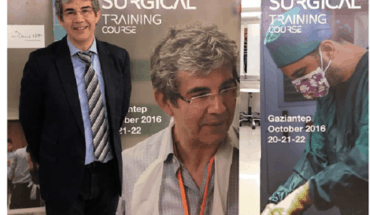I remember very clearly the first time I walked onto the intensive care unit (ICU). The first thing that struck me was that so many of the patients were sitting up, awake. The unit was almost full and in three open bay areas of four beds each nearly everyone had visitors, and most were engaged in conversation. This was not the calm and serene environment that I had seen on TV. Instead of patients being quietly tended to by their nurse, surrounded by quiet, rhythmic beeping, there was constant movement around the unit as staff came and went freely, visitors updated their loved ones on happenings in the outside world, and no interaction was conducted in hushed tones. There was a very perceptible buzz of activity, and it was clear that everyone was doing their own thing that they were just getting on with, but it was difficult to focus on any one group to pinpoint exactly what was happening.
This didn’t feel like a place where it would be easy to rest. Indeed, when I returned to my computer it did not take much investigation to discover that alarms, like the human scream, are acoustically “rough”, and activate areas of the brain that recognise danger and that volunteers in a simulated intensive care environment experienced disrupted sleep patterns and exhibited biochemical markers of stress.
To the uninitiated intensive care is utterly bewildering. Each bed space is at the same time both identical and yet individual. Monitors next to each bed display every heartbeat of the occupant. Every breath. Finely tuned alarms sound loud alerts when something might be going wrong. There is always an alarm sounding somewhere.
A review published in 2012 reported no study of ICU sound levels conducted between 1999 and 2010 recorded levels that were adherent to World Health Organisation guidelines. These recommend that noise levels in hospitals should be around 35dBA with maximum values of just 40dB. In our own unit, we recorded average sound levels of just under 60dBA during the day with peaks above 100dBA almost 30 times every hour. Although the unit was less hectic at night, we still identified peak sounds above 85dBA several times an hour. This is like being in a busy restaurant with a pneumatic drill going outside the door all hours of the day and night. I wouldn’t fancy my chances at sleep there either.
And it’s not just the patients. High noise levels are associated with increased stress levels in staff, and studies in the community have shown that noise affects physiology, motivation, and general health. Sensory overload is a real problem for ICU staff. The brain can only cope with so much information and loss of situational awareness amongst staff is well-known. It has also been reported that up to 75% of alarms do not need to sound. With so many unnecessary alarms constantly clanging it is not surprising that alarm fatigue is high on the agenda in both the United States and in the UK. Excessive noise levels can also make it incredibly difficult to concentrate and communicate effectively. In recognising the fallible human influence on patient safety and mistakes, we need to create an environment that is helpful, not a hindrance.
Patients often talk about not understanding the alarms in the ICU. Unexplained sounds can be fire alarms, emergency sirens, or can trigger thoughts of trains, planes, and transport hubs. From the patient’s point of view, it is almost impossible to tell where the alarms are coming from, and to recognise the difference between serious and minor alerts. As a result, they don’t know if they are about to be on the receiving end of a potentially unpleasant experience so they are constantly anxious and on ‘high alert’. None of this helps to maintain an atmosphere of calm and the constant activity and bustle in the intensive care unit means that it is almost impossible to sleep.
Typical sleep in intensive care units is brief and highly fragmented. Observational studies have shown that patients experience around four hours sleep over a whole day. Many have much less than this and few patients seem to experience periods of unbroken sleep that are longer than three minutes. There is a large group of patients who spend day and night watching the hands of the clock slowly click round. When interviewed about their ICU experiences (see online resource made available by the DIPEx charity) patients talk about the need to be allowed to sleep, to be left alone, and not woken repeatedly for nursing or medical care. As part of our current research, we have designed an immersive teaching session where staff can experience the ICU from the patient’s perspective. This includes triggering alarms which is always unexpected, and almost always invokes the startle reaction. Response to this initiative has been incredibly positive with the vast majority of staff saying they had no idea how noisy perfectly normal and routine activities could be, or how disorienting it is simply lying in bed with a restricted view. Almost everyone who has been through the experience has said they will change their practice.
It remains to be seen whether simple practice changes will reduce noise levels in the ICU but we know from reactions to our project that this is a topic that touches everyone. At the heart of every care delivery is the mantra ‘first do no harm’. If the very environment is negatively affecting patients, it seems, in the ICU at least, everyone starts off on the back foot.
- Intensive care’s intensive noise problem - 29th April 2016






